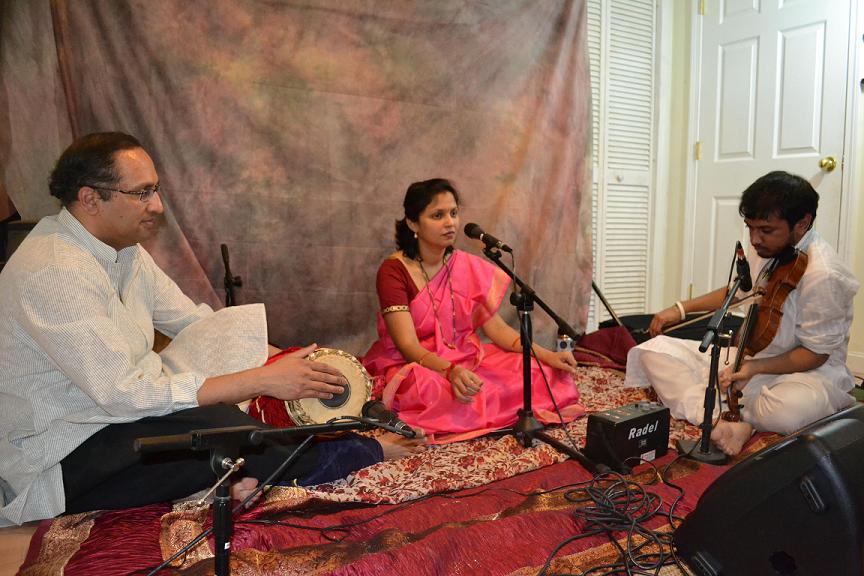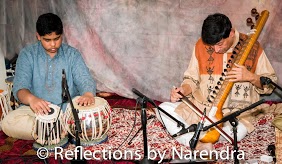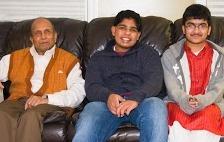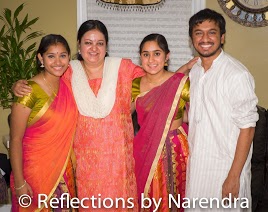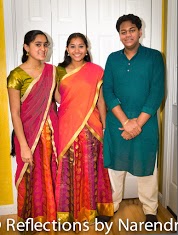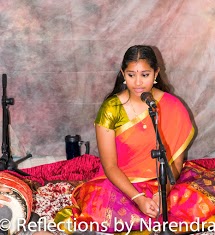Contribute
| KHMC Finale Concert Series Feature Hindustani And Carnatic Concerts |
01/03/2013
KHMC (Karnatic Hindustani Music Circle) successfully ended the year 2012 with its finale concert series on a beautiful day (Dec 8, 2012) at the residence of Jyoti and Narendra Sharma, Nashua. Young artists of local music schools as well as senior artists from New England and Albany area enthralled the audience with their soothing music. A rare instrument, Esraj, turned out to be the star attraction of the day.
Soothing Hindustani Concerts
Jyoti Sharma
The day started with Hindustani Junior segment by a 10th grader, Ashwin Panda accompanied by Pranav Ghatraju on tabla and Bishnu Prasad Panda on Harmonium. Ashwin, who recently completed his Manch Pravesh in Hindustani Classical vocal, began his musical journey as soon as he could sound out syllables from a very early age. After he turned 4, his formal training in Hindustani vocal music began with his grandfather, Shri Bishnu Charan Panda and mother, Swati Panda.
Ashwin rendered Bada Khayal in Raag yaman (Mangal Gao eri Suhagan) followed by Madhyalay in yaman (Hath langar me chhad de re). Following this, he presented beautiful bhajans in raag Kafi, Bhairavi and Jaunpuri that were truly enjoyed by the audience. Finally the audience was thrilled to have an opportunity to listen to a couple of additional beautiful bhajans by Ashwin’s Guru and grandfather Bishnu Prasad Panda who recited at the end.
In the Senior Hindustani segment, Shri Dipankar Deshmukh, accompanied by Pranav Ghatraju on tabla, mesmerized the audience with his rare instrument, Esraj - a unique string instrument played typically with Rabindra Sangeet. First he introduced the audience this special instrument and explained the history of its evolution.
The structure of the Esraj has a medium sized sitar-like neck with 20 heavy metal frets. This neck holds on a long wooden rack of 15 sympathetic strings. The Esraj has four main strings which are bowed. All strings are metal. The soundboard is a stretched piece of goatskin similar to what is found on a sarangi. Sometimes the instrument has a gourd affixed to the top for visual enhancement. The instrument can be rested between the knees while the player kneels, or more commonly rested on the knee of the player while sitting, or also on the floor just in front of the player, with the neck leaning on the left shoulder. It is played with a bow (similar to a double-bass bow, but lighter) with the other hand moving along the strings above the frets. The player may slide the note up or down to achieve the portamento, or meend. The Esraj is mostly used as an accompanying instrument. It is the accompanying instrument of choice for Rabindra Sangeet singing. However, it has also been used as a solo instrument to interpret Hindustani Classical Music, mostly in the Vishnupur tradition. Possibly the most famous exponent of the Esraj has been Pandit Ranadhir Ray, who died in 1988. Today, the best known exponents are Buddhadeb Das, and Abir Singh from Santiniketan.
Shri Dipankarji commenced his performance by Raga Darbari Kanada with short alap, followed by Vilambit composition in teental, short madhya laya composition in teentaal, Rabindrasangeet "Mandir'e mamo" in Ektaal (Raga Adana - mishra) followed by drut and jhala compositions (using "ekhara taans") in teental, raga Darbari. In Raga Hameer, he presented Rabindrasangeet "nayana bhaashilo jole" composition in Chautaal. Resourceful Dipankarji also played Raga Sahana & Sahana Bahar compositions in Ektaal and Raga Bhairv in Rabindrasangeet "Shakaruna Benu Bajaye" in Dadra. True to his musical lineage, Shri Dipankar Deshmukh, a disciple of Sarod Maestro Pandit Buddhadev Dasgupta of the Shajahanpur Gharana and Esraj Maestro Pandit Sugato Nag, mesmerized the audience with his soothing music on the Esraj.
Musical Chemistry by Young “Trioâ€
Vidya Raman
The junior segment of Carnatic music featured a vocal recital by Pavithra Deverajan, a student of Smt. Tara Bangalore, Anubhava School of Music. She was supported by Sahana Srinivasan on the violin (also a student of Smt. Tara Bangalore) and Tarun Bangalore on the Mridangam who learns from Dr. Pravin Sitaram.
Pavithra started the evening with a krithi, Gana Nathane Guna Bodhane in ragam Saaranga followed by a soulful rendering of Mamavapattabhi raama in ragam Manirangu. Pavithra’s pace of rendering the krithi with bhakti and bhavam was so apt that one could get immersed in the song and imagine Lord Rama’s pattabhishekam!
The main piece of the evening was a Krithi, Raju Vedale Joothamu, in Ragam Thodi with neraval and swaram at "Kaaveri Theeramu nannu". She brought out the raga bhavam in just two lines and elaborated it with ease exploring three octaves with flawless rendering. It was delightful to watch younger students in the audience identifying the raga at the outset which speaks a lot about the singer and the Guru. Sahana Srinivasan showed her mastery over the raga bringing all aspects of Thodi in her violin while beautifully reaching panchamam in the higher octave. It was as though her violin was singing along with Pavithra! Tarun Bangalore supported the concert with graceful rhythm on the Mridangam. His lively thani avartanam in Roopaka talam clearly showed his talent.
Pavithra continued with Vande Matharam in Ragamalika followed by the famous Meera Bhajan, Hari tum harojan ke bhir. The audience was moved since the song was sung with so much devotion and this is where Tarun supported Pavithra in a manner that enhanced her music through his sensible and sensitive accompaniment. Tarun has certainly imbibed subtle nuances of accompaniment from his Guru!
Pavithra continued the evening with the famous cine song, Kaatrinile varum geetham in Sindhu bhairavi that captivated one and all. Everyone enjoyed Sahana’s unique accompaniment to this song. Young in age, she displayed great maturity and it was clear that she too was enjoying the evening! Pavithra concluded her recital with a fast paced Thillana, Geetha dhwaniku taka dhim in raga Dhanashri.
A good chemistry among the young “Trio†made the evening enjoyable. Tarun’s pleasing rhythm on the Mridangam, Sahana’s aesthetic perfection on the violin blended well to make Pavithra’s melodious performance truly rewarding to both the performers and the spectators.
Relaxing and Enjoyable Evening of Carnatic Music
SAM Dasan
The second part of the carnatic music segment was presented by Smt. Chandrika Pai from Albany, NY. Accompanying her were local stars Sri Suhas Rao on the violin and Sri Pravin Sitaram on the Mridangam.
The concert started with the ever delightful Ata tala varnam in Kambhoji (Sarasijanabha), which was nicely rendered with the pallavi, anupallavi and mukthaiswaram presented in three kalams, showcasing the artiste’s good grasp of laya. This was followed by the Malahari krithi “Pancha matanga mukham,†which was rendered with feeling and finished off with brisk swarams. GNB’s composition “Ranjani niranjani†in Ranjani was next up and was delivered at a brisk pace with all the subtleties highlighted nicely.
The sub-main piece was Tyagaraja’s “Nee dayarada†in Vasanta Bhairavi. The krithi was prefaced by a nice alapana and Suhas responded with equal fluency. The rendition of the krithi followed by a nice exchange of kalpana swarams between the vocalist and the violinist created a serene mood. Dikshitar’s Navagraha krithi “Smaramyaham sada Rahum†in Rama Manohari sung at a dynamic pace provided a nice lead into the main piece. The piece featured some inspired swarams with nadai intricacies that both the singer and the violinist executed very nicely.
Smt. Pai’s main piece was the Tyagaraja classic “Chakkani Raja†in Karaharapriya. She started this piece with an alapana that was sung with bhava. Suhas was more than equal to the task with an excellent response. The krithi itself was rendered at a gait that nicely brought out the devotional mood that the sahityam evokes. The neraval and swarams at “kantiki sundara†provided a nice climax to the whole piece. Sri Pravin Sitaram’s tani avartanam was dynamic and his mastery was extremely pleasing to the audience- an apt climax to the Tyagaraja masterpiece. The concert concluded with two thukkadas in Kannada- “Kande na Udupi Krishnana†in Behag and “Karedare Barabarade†in Veena Vahini.
Overall, Smt. Pai served up a very relaxing and enjoyable evening of carnatic music. Suhas on the violin was stellar and his accompaniment significantly embellished the performance. Sri Pravin Sitaram’s anticipation and support through the concert served to further enhance the presentation. Thanks to all the artistes for an enjoyable evening.
You may also access this article through our web-site http://www.lokvani.com/
